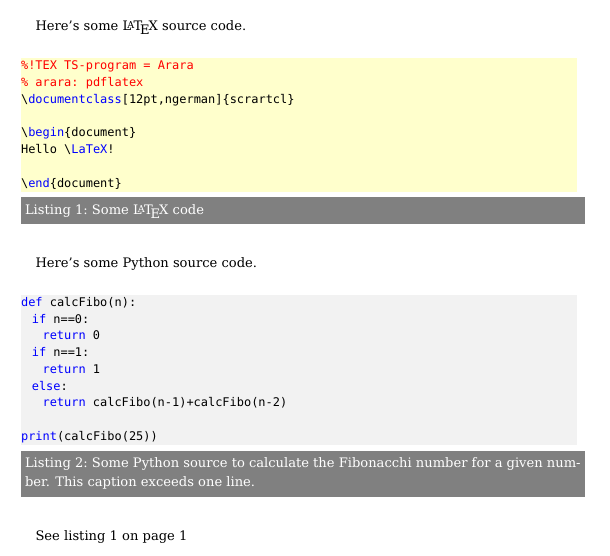How to define several listing environments
The following example shows how to define several listing environments with different highlightings and style settings.
\documentclass{scrartcl} \usepackage{listings} \usepackage{xcolor} \usepackage{bera} \definecolor{hellgelb}{rgb}{1,1,0.8} \definecolor{colKeys}{rgb}{0,0,1} \definecolor{colIdentifier}{rgb}{0,0,0} \definecolor{colComments}{rgb}{1,0,0} \definecolor{colString}{rgb}{0,0.5,0} \lstset{% basicstyle=\ttfamily\small% } % http://tex.stackexchange.com/questions/159419/different-colors-for-default-and-language-specific-listings \lstdefinestyle{mytexstyle}{ float=hbp,% identifierstyle=\color{colIdentifier}, % keywordstyle=\color{colKeys}, % stringstyle=\color{colString}, % commentstyle=\color{colComments}, % columns=flexible, % tabsize=2, % % frame=single, % extendedchars=true, % showspaces=false, % showstringspaces=false, % backgroundcolor=\color{hellgelb}, % breakautoindent=true, % captionpos=b% } \lstdefinestyle{mypythonstyle}{ float=hbp,% identifierstyle=\color{colIdentifier}, % keywordstyle=\color{colKeys}, % stringstyle=\color{colString}, % commentstyle=\color{colComments}, % columns=flexible, % tabsize=2, % % frame=single, % extendedchars=true, % showspaces=false, % showstringspaces=false, % backgroundcolor=\color[gray]{0.95}, breakautoindent=true, % captionpos=b% } % http://stackoverflow.com/questions/741985/latex-source-code-listing-like-in-professional-books?rq=1 \usepackage{caption} \DeclareCaptionFont{white}{\color{white}} \DeclareCaptionFormat{listing}{\colorbox{gray}{\parbox{\textwidth}{#1#2#3}}} \captionsetup[lstlisting]{format=listing,labelfont=white,textfont=white} % http://www.golatex.de/caption-fuer-lstnewenvironment-t9200.html \lstnewenvironment{mytex}[2] {\lstset{language={[LaTeX]TeX},style=mytexstyle,caption={#1},label={#2}}} {} \lstnewenvironment{mypython}[2] {\lstset{language={Python},style=mypythonstyle,caption={#1},label={#2}}} {} \begin{document} Here's some \LaTeX\ source code. \begin{mytex}{Some \LaTeX\ code}{latex} %!TEX TS-program = Arara % arara: pdflatex \documentclass[12pt,ngerman]{scrartcl} \begin{document} Hello \LaTeX! \end{document} \end{mytex} Here's some Python source code. \begin{mypython}{Some Python source to calculate the Fibonacchi number for a given number. This caption exceeds one line.}{py1} def calcFibo(n): if n==0: return 0 if n==1: return 1 else: return calcFibo(n-1)+calcFibo(n-2) print(calcFibo(25)) \end{mypython} See listing \ref{latex} on page \pageref{latex} \end{document} |
